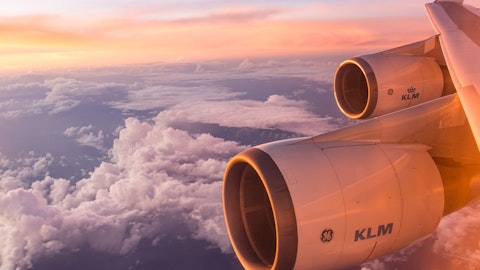Frontier Group Holdings, Inc. (NASDAQ:ULCC) Q2 2023 Earnings Call Transcript August 1, 2023
Frontier Group Holdings, Inc. misses on earnings expectations. Reported EPS is $0.09 EPS, expectations were $0.28.
Operator: Thank you for standing by and welcome to the Frontier Group Holdings’ Second Quarter Earnings Call. At this time, all participants are in a listen-only mode. After the speakers’ presentation, there will be a question-and-answer session. [Operator Instructions] Please be advised that today’s conference is recorded. I would now like to turn the call over to your host Mr. David Erdman, Senior Director of Investor Relations. Please go ahead.
David Erdman: Good afternoon, everyone and welcome to our second quarter 2023 earnings call. Today’s speakers will be Barry Biffle, President and CEO; Jimmy Dempsey, EVP and CFO; Daniel Shurz, Senior Vice President, Commercial. Each will deliver brief prepared remarks, and then we’ll get to your questions. But first, let me quickly review the customary Safe Harbor provisions. During this call, we will be making forward-looking statements, which are subject to risks and uncertainties. Actual results may differ materially from those predicted in these forward-looking statements. Additional information concerning risk factors which could cause such differences are outlined in the announcement we published earlier, along with reports we filed with the SEC. We will also discuss non-GAAP financial measures, which are reconciled to the nearest comparable GAAP measure in the appendix of the earnings announcement. So I will give the floor to Barry to begin his remarks. Barry?
Barry Biffle: Thank you, David, and good afternoon, everyone. Despite challenging operational conditions, we generated strong second quarter results with a pre-tax margin of 9.1%. Our highest post-pandemic margin on an industry-leading capacity growth of 23%, compared to the prior year quarter. Our continued focus on cost management help drive a beat on our non-fuel operating expense. Our total cost structure is significantly lower than the industry average generating an advantage of more than $70 per passenger today. Our cost structure is a key element in underpinning our growth strategy and I’m proud the organization has continued to ensure we remain the leader among our peers. Ancillary revenue continued its strong performance during the second quarter, achieving $80 per passenger, $5 higher than the comparable quarter last year.
We expect our industry-leading ancillary platform to continue to provide us with pricing flexibility to tailor our suite of products and services to our customers’ needs. It also enables us to maintain low fares and enhance engagement and loyalty with our brand. Our GoWild All You Can Fly Pass is a great example. Since a substantial number of our pass holders do not have prior travel history with Frontier, we’ve had the opportunity to expand brand awareness and preference, along with driving incremental revenues as these customers engage with our other loyalty platforms such as Discount Den, our co-branding credit card, as well. It’s a key part of our strategy to increase the contribution from loyalty and subscription-related products. As we look to the third quarter, we expect a moderation in fares largely due to the increase in competing long-haul international travel flows.
To better understand this phenomena, we recently surveyed our Frontier customers. Survey found that 5% or more of our customers have traveled or plan to travel to Europe versus last year. We estimate this environment to be a three-point temporary headwind on a pre-tax margin basis. Encouragingly, our survey also revealed over 90% plan to travel the same or more with over half planning to travel more on a go-forward basis giving us the confidence that once the balance shifts back to domestic, we believe RASM will normalize. Turning to the operational environment, the challenging conditions experienced in June continue to cause an historically elevated level of cancellations. Weather across the United States, in particular, in Florida, has produced record air traffic control delay programs resulting in the cancellation of over 3% of our flights in July.
We are incorporating ATC constraints into our network design going forward and we expect this environment to impact our third quarter pre-tax margin by approximately three points. Accordingly, we anticipate our third quarter adjusted pre-tax margin to be 4% to 7%. With the lowest cost structure of any carrier in the United States and we are focused on sustaining that advantage with ongoing induction of the hi gauge, fuel-efficient, A321 Neo aircraft and by leveraging our high utilization capabilities to drive low fares and stimulate demand. With that, I’ll hand the call over to Daniel for commercial update.
Daniel Shurz: Thank you, Barry, and good afternoon, everyone. Total operating revenue for the second quarter of 2023 was $967 million, more than 6% higher than the prior year quarter. RASM was down 14%, 10% on a stage-adjusted basis. From a strong prior quarter, our capacity growth was 23% over the same period and an 8% increase in stage length. Revenue per passenger was $127, 9% lower than the 2022 quarter, during which time fuel prices were 40% higher and post-COVID domestic travel demand surged. In May, we launched promotional and other GoWild seasonal product, the fall and winter, pass for travel, from September through February. The pass included access to more than 85 US and international destinations. Furthermore, lastly, we put the new GoWild monthly pass on sale, given even more customers the opportunity to enjoy the best value in air travel.
Turn to a brief network update. In the second quarter, we launched 26 new routes, originating from Atlanta, Baltimore, Chicago, Midway, Cleveland Detroit, Houston, Orlando, San Juan, St. Thomas and Tampa. These new routes were all added to existing Frontier airports, which increases our customer appeal in key markets. That concludes my remarks and I’ll now yield the call to Jimmy.
Jimmy Dempsey: Thank you, Daniel second quarter results reflect a pre-tax margin of 9.1%, a post-COVID record. The results reflect strong demand throughout the quarter and diligent management of our cost base. Revenue increased 6% on a 23% increase in capacity, while fuel expense was in line with guidance at average cost per gallon of $2.69. Adjusted non-fuel operating expenses were $644 million, beating guidance or $6.09 on a unit basis, 5% lower than the 2022 quarter. We ended the quarter with $780 million of unrestricted cash and cash equivalents or $350 million net of total debt. In addition to our cash bonds, we also have access to substantial liquidity through our unencumbered loyalty and brand-related assets. We had 126 aircrafts in our fleet at June after taking delivery of three A321 Neo aircrafts during the quarter, two of which were financed with direct leases.
Having already experienced significant aircraft delivery delays across the first half of the year, Airbus has informed us that any further delays should be modest. As such, we expect to end the year with 136 aircrafts. Turning to guidance, third quarter capacity growth is anticipated to be in the range of 21% to 23% over the 2022 quarter, while full year 2023 capacity is expected to affect growth of between 19% to 21% over the prior year. Fuel costs are expected to be between $2.80 and $2.90 per gallon in the third quarter and $2.90 to $3 per gallon for full year 2023 based on the blend of fuel curve on July 24th. Adjusted non-fuel operating expenses in the third quarter are expected to be between $650 million to $665 million and $2.535 billion to $2.585 billion for the full year.
This range incorporates the costs related to our challenging operating conditions. Finally, reflecting Barry’s earlier comments on the operating environment, adjusted pre-tax margin in the third quarter is expected in the range of 4% to 7% and 4% to 6% for the full year. With that, I’ll turn the call back to Barry for his closing remarks.
Barry Biffle: Thanks, Jimmy. I want to personally thank team Frontier for their dedicated service during the quarter in a difficult operating environment and for delivering low fares done right. We remain focused on controlling the things we can control to run a sound operation, despite challenges posed by extraneous factors. Our competitive edge lies in sustaining our cost advantage over the industry and we intend to utilize this advantage to simulate leisure travel demand and maximize shareholder value. I want to be clear, while we’re disappointed in our projected results, I strongly believe the company will return to double-digit margins given that most of the headwinds are temporary. I want to thank everyone again for joining this afternoon and we’re ready to begin the Q&A portion of the call.
See also 25 Countries with the Most Beautiful Women in Europe and 12 Best Small Cap Tech Stocks To Buy.
Q&A Session
Follow Frontier Group Holdings Inc.
Follow Frontier Group Holdings Inc.
Operator: [Operator Instructions] Our first question comes from Brandon Oglenski of Barclays. Your line is open.
Brandon Oglenski : Hey, good afternoon and thanks for taking my question. So, Barry, I guess, can you expand on that a little bit, because you had been guiding I think for like 10% to 12% or 10% to 13% pre-tax margin the back half of the year. This seems like you’re pulling that back somewhere around 4% to 6% at the midpoint. And I think you did mentioned three points from restructuring operations around Florida and ATC. So can you maybe dive deeper into that, please?
Barry Biffle : Yeah, sure. It’s pretty simple math. We laid out – we had put out a 10% to 13% expectation for the second half, and we are seeing roughly three points in the operational challenges as we discussed. The ATC ground delay programs, and so forth. And we’re seeing an additional three points in the revenue environment, which is primarily driven by the shift to European travel. So that pretty much explains the six points. I think it might be a little bit more fuel in there, as well but that explains it all.
Brandon Oglenski : What – I guess, Barry, can you talk about the changes around those operational challenges, because it looks like your capacity guidance maybe didn’t move all that much. So does this go beyond just capacity?
Barry Biffle : No, no. This is this is just simply – it started a little bit in May, but really took effect in kind of your mid June time frame and it’s continued through the last six weeks pretty heavily. We see maybe even a similar storm event. We will see ground delay programs start hours and hours before with significantly longer and lots more minutes. And so, we planned our airline in the past and we had roughly three hours of buffer built in. And we’re seeing consistently with these kind of ground delay programs, we need around four hours. So, we’ve made some tweaks to it. But there’s no real immediate fixes that will fix this in the near term until – but when we look forward to next year, and beyond, we will start factoring this into our plans.
The reality is that ATC is just issuing more ground delay programs and they’re at lasting considerably longer than we’ve seen in the past. And so we’ve got a plan for that. But in the meantime it’s a drag and so we can kind of schedule around with the fuel.
Brandon Oglenski : Okay. Appreciate that, Barry? And then, Daniel, maybe can you expand on the European comment? Overseas travel, this is not the first time we’ve heard it this quarter. Should we be thinking that folks have more propensity to travel internationally this year than they will next year?
Daniel Shurz : Look, what we know, Brandon is that, as I said our customer, we surveyed our customers air traveling to Europe more, but this commonality from, others, there seems to be there is seems clearly pent-up demand for long-haul international travel and from a US point of origin perspective, that skews very, very heavily to Europe. We don’t know. We don’t know, what we don’t obviously know exactly what’s going to happen in the future, but what we’ve seen in pent-up demand – what we’ve seen in pent-up demand Germany is the first time you see that pent-up demand. That’s one of the strongest and it tends to ease off as you go forward.
Brandon Oglenski : Okay guys. Thank you.
Operator: Thank you. One moment, please. Our next question comes from the line of Duane Pfennigwerth of Evercore ISI. Your line is open.




